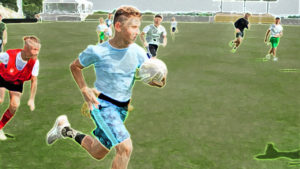Ruggers need a high level of cardiovascular fitness. Cardio fitness is your ability to take in, transport, and utilize oxygen, and is often expressed as your V02 max. It’s also dependent on your heart, lungs, and circulatory system, plus you need the endurance to keep your muscles moving as fatigue starts to accumulate.
Traditionally, cardio fitness is developed by running, and as rugby involves a lot of running, as much as 5-8 km per game, it makes sense that running should be part of your workouts and training programs.
However, ruggers are not featherweight marathon runners – they’re big, strong, burly athletes with a greater-than-average body mass, and that means doing a lot of running could lead to injury.
Building a cardio base for rugby
Building a cardio base is normally an off-season activity; it’s when you develop a solid level of general fitness so that, when it’s time to start training more intensely, your body is adequately prepared. A good level of cardio fitness will ensure you recover more quickly between sets of strength training and interval training, and more quickly between workouts too.
To develop a cardio base, your training needs to be aerobic in nature, and that means low to moderate intensity exercise, sustained for relatively long periods of time. You can read more about developing cardiovascular fitness in our article – How much cardio do rugby players really need? – then grab one of our supplements or custom stacks before you get to work!
Here are some joint friendly training methods that are perfect for rugby players:
1) Circuit training
Circuit training was invented at Leeds University in England way back in the 1960s. It’s a system of training that was designed to improve cardiovascular fitness and muscular endurance all at the same time – sounds perfect for ruggers, right?!
Simply choose 8-12 preferably compound exercises, and perform them back to back. Rest a moment after completing the final exercise, and then repeat. You can use bodyweight exercises, free-weight exercises, kettlebell exercises, TRX exercises, or a combination of the above. Work for a set number of reps or time per station.
Example circuit:
Do 45 seconds of each exercise, rest 1-2 minutes between laps. Do as many reps as you can per station.
- Speed squats
- Push-ups
- V-sits
- Step-ups
- Bench dips
- Medicine ball slams
- Jump rope/jump jacks
- TRX rows
- Kettlebell swings
- Supine back extensions
Avoid placing overlapping or similar exercises back-to-back, as localized muscular fatigue will reduce your work rate, decreasing the cardiovascular benefit of your workout. Instead, use non-competing exercise, e.g. legs/upper body/core.
2) Swimming
Swimming is the ultimate in non-impact exercises, and a very good cardio choice for ruggers. Because your bodyweight is supported by the water, the risk of impact-related injury is zero, nada, zilch!
However, for swimming to be an effective cardio workout, you need to be a half-decent swimmer. To develop your fitness, you need to be able to keep on swimming for a sustained period of time. The best stroke for developing cardio fitness is freestyle, sometimes called front crawl.
If, because of poor technique, you have to stop every lap or so to empty your lungs of water, swimming probably isn’t right for you.
Can’t swim, won’t swim? Try deep water running instead. Think big guys can’t swim? Check out this video of 400 lb. World’s Strongest Man Eddie Hall making it look easy:
3) Rowing
Rowing is one of the best cardio options for ruggers – period. In fact, we’ve written about this before. For more details on rowing for rugby, make sure you check out that previously linked article which includes a beginners and advanced workout programs.
What makes rowing such a good workout for ruggers? Good question! As well as being low impact, it’s a full body workout that requires and develops coordination, breathing discipline, and emphasizes your posterior chain – the muscles on the back of your body. It’s also easy to learn, and perfect for big-framed ruggers.
There are only two real downsides to rowing. Firstly, you’ll need regular access to a rower. They can be expensive to buy, but most gyms have one. Secondly, rowing can be uncomfortable for your butt! This is easily remedied by using a foam seat pad, and taking short breaks of 15-30 seconds every 10-15 minutes or so.
Make sure you get the best from your rowing workouts by using proper technique – as demonstrated in this video:
4) Cycling
Whether you ride a road bike, a mountain bike, or use an exercise or spinning bike, cycling is a good cardio base builder for ruggers. Low impact, cycling works all your major lower body muscles, which is a necessity for driving your heart and breathing rate up.
If you choose to cycle outdoors, makes sure you put safety first by wearing high-visibility clothing, wearing a helmet, and respecting the rules of the road. Even then, be vigilant because not all motorists are as cyclist-aware as they should be. Cycling is not the best time to crank up your MP3 player and tune out – you need all your senses to avoid accidents.
Indoors or outdoors, make sure your bike is set up right for you. That means adjusting your saddle height so your knees are only slightly bent at the bottom of each pedal stroke, and that your seat is level or even slightly above your handlebars. If you don’t set up your bike properly, you could end up in a lot of discomfort, and not just from a hard saddle.
Speaking of saddle soreness, that is easily avoided by investing in a pair of padded cycling or rugby shorts. If you intend to make cycling your main form of cardio conditioning, this is a very good investment.
5) Rucking
Being a rugger, you are already familiar with the term rucking, except this is a different kind of rucking that has nothing to do with fighting for possession of the ball. Rucking is a low-impact military-inspired workout that is a great alternative to running, and is ideal for ruggers looking to develop a high level of cardiovascular fitness.
Rucking is essentially fast walking, often over rough terrain, while carrying heavy loads. Almost all branches of the military use rucking to transport men and equipment from point A to point B. Walking speed, load, and distance can all be adjusted to vary the demands of the workout.
While many ruckers love to head out into the great outdoors and go head-to-head with mother nature, there is nothing to stop you rucking in a more urban environment. Rucking up short, steep hills is a great alternative to hill sprints that, despite being low impact, will develop fitness and burn fat very effectively.
To ruck, you need a loaded rucksack or back pack, or a weighted vest. Start out with around 10-15 percent of your bodyweight on your back, and increase from there.
Although rucking is a low impact activity, the extra load will increase stress on your joints. Make sure you wear cushioned, supportive footwear to minimize your risk of injury. You can learn a little more about rucking in this video:
Choosing your cardio strategy
So, which one is right for you? The answer depends on your personal preferences. Ultimately, your heart, lungs, and circulatory system don’t know why they are working harder, they just respond to the job at hand.
Providing you increase the demands of your workout as you get fitter, your cardio abilities will improve – whether you ruck, row, swim, or run. Remember though, you need more than conditioning to be a good rugger, and cardio should just be one part of your rugby training program.
Get the most from whatever cardio workouts that you do by using BeetElite to boost stamina and muscular endurance or NOxide for post-exercise recovery.


